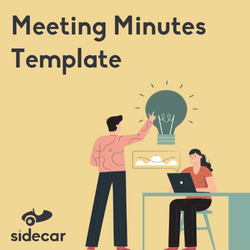Taking meeting minutes is important for both historical record-keeping and as a reference for guests who couldn’t attend. Despite the nomenclature, meeting minutes don’t have anything to do with actual minutes — meeting minutes are just about documenting the key decisions that were made and what’s to come next as a result.
Keep reading for helpful tips on how to take meeting minutes effectively, what you should include in your notes and a simple template you can copy.
Why are meeting minutes important?
While recording meeting minutes can seem time-consuming, they offer plenty of benefits that can help keep your association moving forward. Some uses of meeting minutes include:
- They offer structure – With busy schedules, recording minutes can be a great way to keep meetings on track. More often than not, the person taking meeting minutes will set an agenda ahead of the meeting, outlining the topics and action items that need to be covered.
- They improve results – An important part of the meeting minute process is recording action items and assigning them to someone within the organization. Not only will this help keep track of progress, but also it allows leadership and members to take ownership over specific tasks.
- They help with transparency – Whether you need to file your association’s meeting minutes or you’re simply creating a reference point for those members who couldn't attend, meeting minutes allow your organization to remain transparent with every meeting.
Robert’s Rules of Order
For the association and non-profit world, meeting minutes are likely already in use because they’re required by Robert's Rules of Order. While they outline information that must be included in your meeting minutes, like the type of meeting and who’s in attendance, they’re also critical for introducing and voting on motions.
- Introducing Motions: This should include the details of the motion as well as the person introducing them. Motions can be actions the board needs to take or even questions that should be answered.
- Voting: Just as the motion is important, so is the voting. In your meeting minutes, you will not only track the votes but also attribute them to specific members to ensure accuracy and transparency.
Of course, these additions to your meeting minutes depend greatly on the type of organization and the purpose of the meeting. However, when explaining why meeting minutes are important, it’s critical to remember that they also allow your entire team to be on the same page while offering data your organization can use down the line to track the success of initiatives along with task management.
What to include in meeting minutes
Have you been tasked with recording the meeting minutes of an upcoming board meeting? Here’s what your meeting minutes need to include:
- Time, date, and location of meeting
- Meeting attendees (both present and absent listed)
- Agenda items covered
- Decisions made during the meeting
- Status of open action items
- Action items to be completed before the next meeting
- Details on the next meeting (date and time)
A common question about meeting minutes is why you should include the names of all attendees and absent members. This is done for two reasons – to keep everyone informed and to document attendance. For board of directors meetings, for example, it’s important to have active participation. If a member is consistently absent, the meeting minutes can act as a record.
Another common question is who’s responsible for recording meeting minutes. The secretary is generally the one responsible for keeping records. If they are absent, someone can be appointed, however, this can vary from organization to organization.
The right way to record meeting minutes
So you may be asking yourself, “how do I take meeting minutes?”

Meeting Minutes Template
Taking meeting minutes is important for both historical record-keeping and as a reference for guests who couldn’t attend. Despite the nomenclature, meeting minutes don’t have anything to do with actual...
Download Now
For starters, it’s important to note you don’t need to record every single thing said in the meeting. In order to record excellent minutes of a meeting, this is what you should do before, during, and after your meetings:
Before the meeting
A meeting agenda should be created before it’s time for the meeting to start. An agenda gives the meeting structure and also provides you with an outline for crafting your meeting minutes and notes. This helps everyone stay on track and ensures attendees are properly prepared for an effective session.
In addition to creating an agenda ahead of the meeting, you can also pre-fill your meeting minutes template with the information you know ahead of time, like the meeting date, time, location, agenda items, names of participants, and other details you’re already aware of. This way, you won’t waste time during the meeting and miss important discussions.
Tip: By setting action items during the meeting, meeting attendees will likely set due dates for any assignments. Be sure to check statuses with attendees ahead of time to determine what action items may need more attention.
During the meeting
Meeting minutes don’t need to be a literal minute-by-minute reporting of what was said and done. They do, however, need to capture the most important things that were said in a clear and simple format.
As the meeting begins, take note of who on the participant list has joined and who has not. You need to know who’s who so you can accurately document who said what — if you don’t already know, introductions at the beginning of the meeting will be necessary.
While you’re taking minutes of a meeting, don’t try to record every conversation word for word. Instead, focus on capturing the decisions made and next steps. However, if a particular agenda item triggered debate and arguments, be sure to take note of what was said on each side, and what the final decision was. In your meeting notes, record how much time was spent on each agenda item.
Don’t be afraid to speak up during the meeting to ask for clarification. You might need to clarify the next steps, final decision, or ownership of action items if it’s unclear during the discussions.
Tip: While your notes will be the key document used, you can also record audio from the meeting as a backup to verify any pertinent information. However, once those meeting minutes are approved and filed, any audio recording should be destroyed.
After the meeting
Edit and format your meeting notes for simplicity and clarity. You also want to check for consistent verb tense — past should be used for meeting minutes. Clean up your meeting notes as shortly after as possible, while the content of the meeting is still fresh in your mind.
Tip: Make sure that your minutes are purely factual and straightforward — there should be no commentary here.
Do meeting minutes need to be signed?
As mentioned before, one of the biggest benefits of recording meeting minutes is giving your organization a sense of transparency. It’s important for meeting minutes to be accurate because they can offer legal protection, as meeting notes are considered official records. This is also why they’re often required by your association’s bylaws.
After you’ve finished editing, your meeting notes should be reviewed and approved by an attendee on your team, or the chairperson if you are recording meeting minutes for a board meeting. Once the notes have been approved, share them with all stakeholders and file them appropriately.
Simple meeting minutes template
Learning how to take meeting minutes can be a challenge. So, we’ve created this simple and easy-to-use meeting minutes template for you to copy the next time you’re tasked with taking notes of a conference call or check-in.
[Organization Name] [Meeting Name] Minutes
Meeting date: [date]
Meeting time: [time]
Meeting location: [location]
Meeting called by: [name]
Facilitator: [name]
Notetaker: [your name]
Present: [list names and titles]
Absent: [list names and titles]
AGENDA ITEMS
| Topic | Time Allotted | Presenter | Discussion and Conclusion |
| Topic #1 | |||
| Topic #2 | |||
| Topic #3 |
OPEN ACTION ITEMS
| Task | Responsible Party | Status |
| Task #1 | ||
| Task #2 | ||
| Task #3 |
NEW ACTION ITEMS
| Task | Responsible Party | Deadline |
| Task #1 | ||
| Task #2 | ||
| Task #3 |
Adjournment
Meeting was adjourned at [time] by [facilitator]. The next meeting will be [time] on [date] at [location].
Use meeting minutes to your advantage
Whether they’re required by your bylaws or are simply the norm for your association, meeting minutes are an extremely valuable tool. Not only do they boost transparency for your organization and the decisions made by the board, but also they can help track progress and identify any bottlenecks that affect your organization. Best of all, by using tools like meeting minute templates, you can streamline your entire meeting process too.

July 20, 2021


